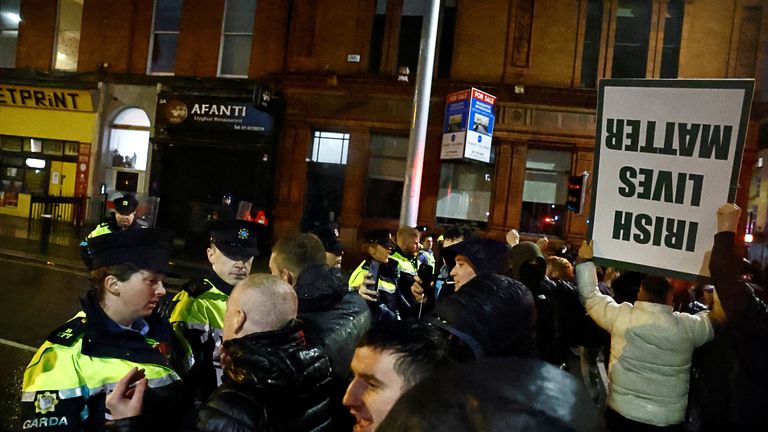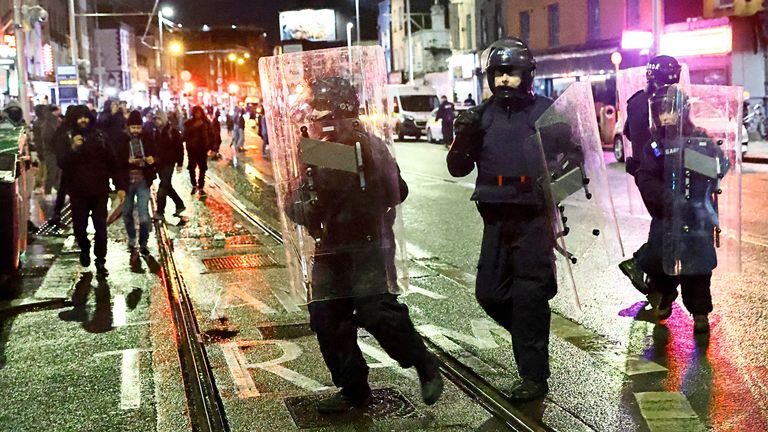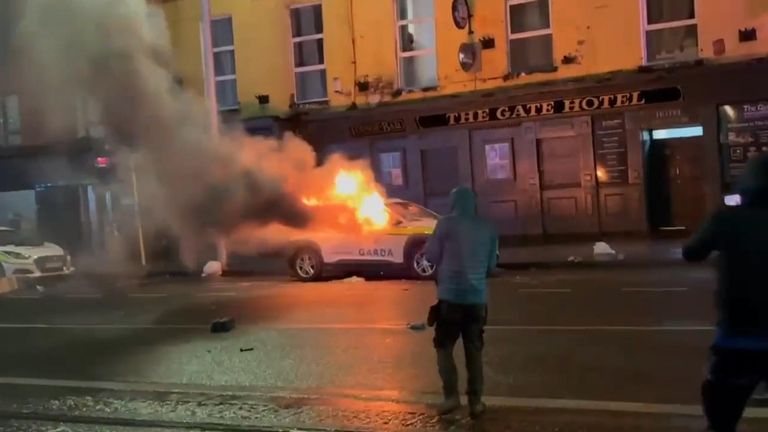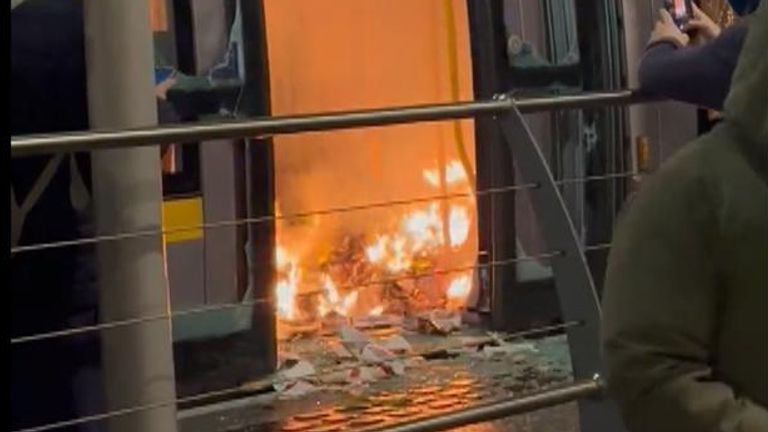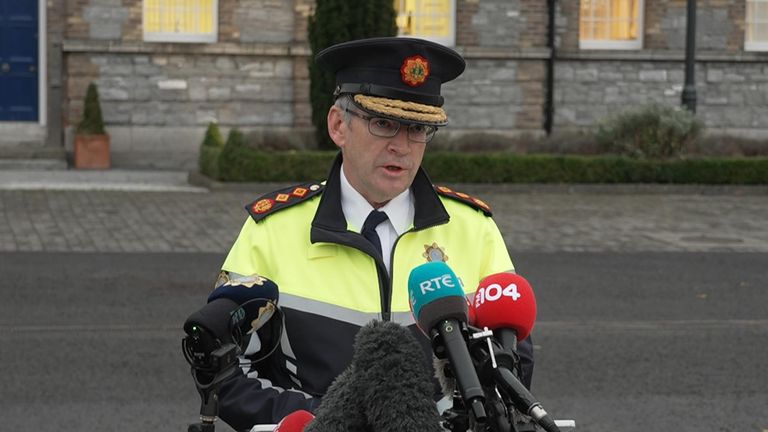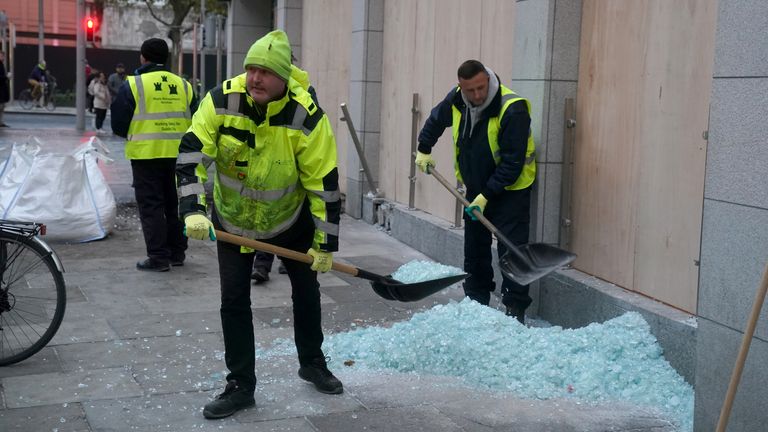Riots broke out in Ireland’s capital Dublin, with “huge destruction by a riotous mob” leading to the arrests of 34 people, Irish police have said.
The violent protest in Dublin was triggered by a stabbing incident outside a primary school which has left a five-year-old schoolgirl in critical condition and a female teacher in her 30s in a very serious condition.
Here’s everything we know about the attack, the riots and how the events unfolded.
The attack
Three young children, a woman in her 30s and a man in his 50s were injured after the knife attack shortly after 1.30pm on Thursday afternoon near Gaelscoil Cholaiste Mhuire, a primary school in Parnell Square East in the north inner city.
Police say a five-year-old girl is in a critical condition in hospital while the female care assistant, in her 30s, is in a serious condition.
The girl, six, remains in hospital but the boy, five, has been discharged.
Garda said the man who sustained serious injuries at the scene is a person of interest in their investigation.
Garda Superintendent Liam Geraghty said members of the public intervened to disarm the attacker “at a very, very early stage” after the stabbings.
Authorities also confirmed that a knife was recovered and a suspect detained shortly after the incident.
They added that they were following a “definite line of inquiry” and were not looking for any other person in connection with the attack.
Do we know the attacker’s motive?
Superintendent Liam Geraghty told reporters on Thursday evening that police were “satisfied” that there was “no terror-related activity” and that the incident appeared to be a “standalone attack”.
He added that they “continue to have an open mind at this early stage of the investigation”.
When did the riots begin and what happened?
Violent scenes began unfolding close to the site of the attack early Thursday evening, with around 500 people rioting, according to Taoiseach Leo Varadkar.
Some were armed with metal bars and covering their faces.
Police said over 400 officers were deployed in Dublin city centre to deal with the riot.
There were clashes with riot police as some demonstrators let off flares and fireworks, while others grabbed chairs and stools outside bars and restaurants.
How much damage was done?
The damage from the riots could cost tens of millions of euros, Taoiseach Leo Varadkar says.
A Garda car was set alight, a Luas tram and several buses on O’Connell Street were set on fire, and another bus and car were torched on O’Connell Bridge as rioters clashed with officers.
A total of 11 Garda cars were damaged and 13 shops were significantly damaged or subjected to looting, Garda Commissioner Drew Harris said.
Foot Locker and Asics shops were among those looted in O’Connell Street, as well as Arnott’s department store in nearby Henry Street.
Bottles were thrown at police on the street, and video obtained by Sky News shows a man putting a burning cardboard box into a police vehicle.
Were there any injuries in the riots?
One Garda officer received a serious injury, while “numerous” other officers were injured as missiles were thrown at them before order was restored between 9pm and 9.30pm, Commissioner Harris said.
Who were the people rioting?
According to police, far-right protesters were involved in the riot after rumours circulated about who was responsible for the attack.
Other than confirming that the injured man in his man in his 50s is a “person of interest” in their investigation, police have not released any details about the identity of a suspect.
“These are scenes that we have not seen in decades but what is clear is that people have been radicalised through social media and the internet,” said Commissioner Harris.
“We have a complete lunatic hooligan faction driven by far-right ideology, and also then this disruptive tendency engaged in serious violence.”
Taoiseach Leo Varadkar said in a separate press conference that the rioters “brought shame on Dublin, brought shame on Ireland and brought shame on their families and themselves”.
What is happening now?
32 people are due to appear in court today in connection with the riot.
Irish Minister for Justice Helen McEntee said there could be prison sentences of up to 12 years for those convicted of attacking officers.
Ms McEntee described a “very volatile situation” and said there was a very strong Garda presence in Dublin as well as monitoring of online activity.
Commissioner Harris warned today that Garda had to make the “assumption that following the events of last night, we are going to see further protests” after blaming “a complete lunatic faction driven by far-right ideology” for the disorder on Thursday.
Meanwhile the clean-up is continuing on O’Connell Street, with burned-out Luas tram carriages lifted off the track by cranes and broken glass and missiles swept away.
There is still a heavy gardai presence in Dublin in response to the riot, but the Taoiseach has insisted that it’s safe for people to go into the city as normal.



